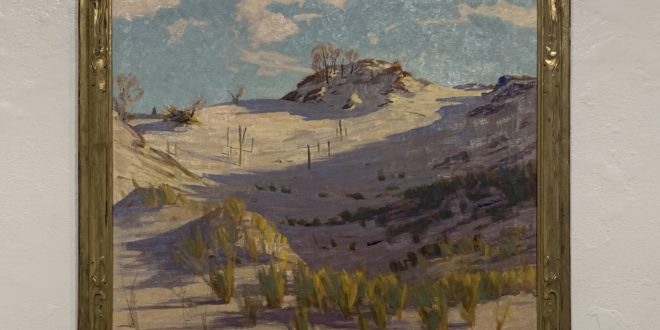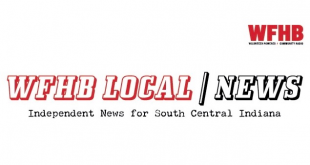Podcast: Play in new window | Download (Duration: 6:58 — 4.7MB)
This post was edited on October 17, 2020 for accuracy. Some facts/pronunciations in the original recording may be incorrect and differ from the text.
State of Nature: Picturing Indiana Biodiversity, was created and put together by the Director of Grunwald Gallery, Elizabeth “Betsy” Stirratt, along with the help of fellow professors, local artists, and the Indiana State Museum.
The experience that the audience gets is truly unique, as a scientist, conservationist, or just a curious townie.
With projected videos, large carcasses, wolves, or artwork, Stirratt hopes there is something for everyone to be able to appreciate Indiana’s natural beauty.
The exhibit began in August and will be open to the public on Wednesdays, Fridays and Saturdays from 12 to 4 until November 18th on an appointment only basis. Appointments can be made by emailing [email protected].
Visitors are required to wear masks and maintain physical distancing protocols to participate.
The exhibit will appear for online 3-D viewing by the second week of October for a virtual walk-through tour.
When asked why this is something fellow hoosiers and students should experience, creator of the exhibit, Betsy Stirratt shared that Grunwald Gallery doesn’t do the same thing that science museums, or many of the museums in Indiana do, because it combines contemporary art with other things such as science or literature.
“We try to put a contemporary art in a context that makes them accessible and relevant” She said, and that the vision for this experience is to let the history tell the story.
Upon opening the doors to the exhibit, I am greeted by a quiet atmosphere, with cool air and grey and white walls, giving the light a softness to it.
At the center of my attention is a black projected screen. A lone, white tree stands in the middle, its branches bare. Slowly, a humming sound fills the space as white shadows of birds fill the branches until there are millions of them, flying upwards. The humming gets louder as the birds multiply. Finally, the birds leave the tree, one by one as the sound dissipates.
The piece I just described is a creation by combined artists Susannah Sayler and Edward Moris (Saylor/Morris) who work with photography, video, writing and installation to project aspects of nature, culture and ecology.
Eclipse, is a video that remembers the passenger pigeon, a species that went extinct over 100 years ago. The Passenger Pigeon is known for being the most abundant bird species in North America, flying in flocks so great that the sky would even darken as they passed overhead.
The National Audubon Society, a non-profit environmental organization dedicated to bird conservation, compared the Pigeons to a noonday eclipse.
On September 1, 1914, the last known passenger pigeon, Martha, died in captivity.
Saylor/Morris acknowledge this species, explaining how the video installation “evokes the once overwhelming, even frightening, numbers of birds as well as their delicate beauty, the sadness of their loss and irreversible disappearance.”
Eclipse is an accurate example for the rest of the exhibit, where each piece can gain thoughtfulness and compassion from the viewer. One person in the exhibit exclaimed, “It invited you to just feel its love” as they study a life size carcass replica of the Jefferson Ground Sloth, a species that has been recovered from Ice Age sites in the Midwest.
During the 19th century when Indiana University was being established, Indiana was covered with lush forests and diverse ecosystems. Fast track to the industrial age and now, urbanization has created a lifestyle of normalizing reliance on technology and as a result, the natural biodiversity of the state has gone neglected.
Nature Deficit Disorder was a phrase coined by author Richard Louv, from his book “Last Child in the Woods: Saving Our Children from Nature-Deficit Disorder.”
Nature-deficit disorder refers to mostly children, who as a whole are spending less time outside, resulting in numerous behavioral problems.
Louv claimed that causes for this may be parental restrictions and fears, and the lure of electronic devices.
In regards to the exhibit, Indiana University biologist and professor, Roger P. Hangarter stated, “As our ecosystems continue to degrade under our feet and around us, State of Nature will provide viewers with a visually compelling place to explore, examine question, connect to and contemplate what we stand to lose if we fail to change the way we treat the natural world.”
Although the exhibits won’t last forever, Stirratt hopes that this one will make an impression on appreciating our surroundings and learning from them.
“One thing this has helped me do is appreciate where I am,” Stirratt reflected.
During the Pandemic, it seems we’ve all had to think about where we are. Stirratt said, “This time has given me an opportunity to do a lot of searching and looking at where I am and I’ve really enjoyed that.”
Stirratt explained her personal interest in how people perceive things in a gallery space. As an artist herself, Stiratt admits, it’s hard to separate the curation part from the creative part.
None of the pieces in the exhibit belong to Grunwald, as everything is borrowed from the Indiana State Museum and participating artists connected to Indiana.
Stirratt said, “I’m working with other artists to make a statement, tell a story about Indiana Biodiversity.”
The exhibit, originally planned to be a part of the IU Bicentennial, ended up an experience in itself and has grown into the creation of much planning.
However, Stirratt explained that you can plan all you want but in the end you have to let the energy of the room take over.
She stated, “Sometimes you don’t know how it’s going to come together until you’re actually in the space with the stuff,”
Her overall hope, she said, is that people can understand that these creatures and landscape lived and evolved in Indiana.
“People tend to not think much about the past, at least in terms of nature so I want people to appreciate what we have here.” She said.
And in return, she thinks the experience people have can, “inform them about what our future might be by paying attention to what they can do to preserve what we have.”
Walking out of the gallery and back into the light of day, filled with the busy sounds of the city, I felt that my perception of the natural surroundings had been reset and the beauty of Indiana seemed brighter than ever before.
 WFHB Bloomington Community Radio
WFHB Bloomington Community Radio






